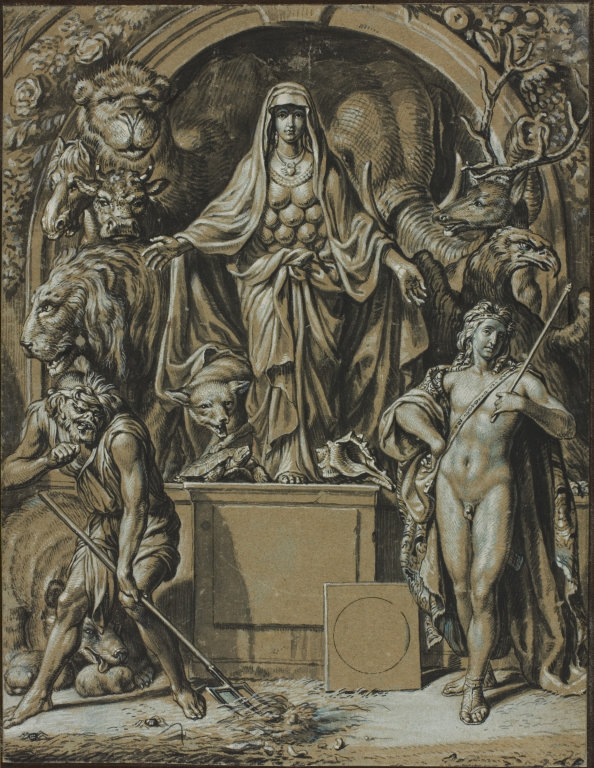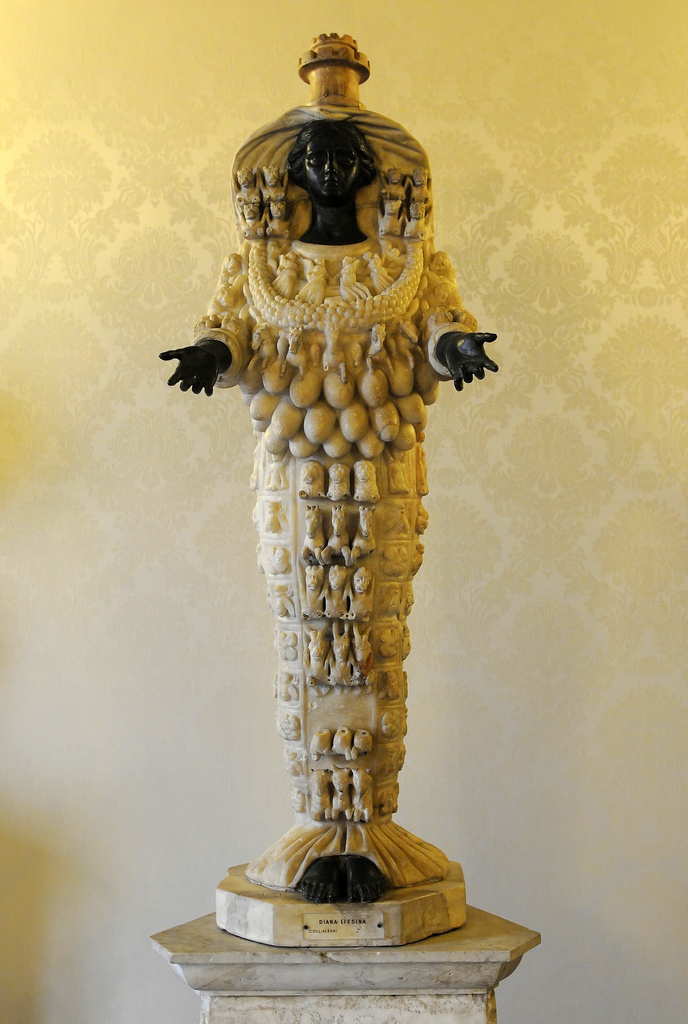Two hundred years ago, the third miracle of antiquity was considered forever ruined. Everything changed in 1869, when the efforts of the English archaeologist found the "burial" of the once majestic Mecca - the temple of Artemis at Ephesus. This story is full of ghosts: neither the temple nor the city in which it was built no longer exists. But tourist pilgrimages to the former place of worship of the goddess of fertility do not stop until now.
Semi-legendary Ephesus
Prior to the founding of the city, ancient Greek tribes lived in its environs, worshiping the cult of the "Mother of the Gods." Then these lands were captured by the Ionians led by Androclus. Invaders were close to the beliefs of their predecessors, so several centuries later on the site of the wooden sanctuary of the fertility goddess Cybele decided to erect their own shrine, which later became known as the Temple of Artemis of Ephesus.

According to legend, the birth of Ephesus occurred under romantic circumstances. According to her, the son of the Athenian ruler Androclus, visiting the oracle, received a prophecy. It said that he should establish a city, which fire, wild boar and fish will help to find. Soon the ship was equipped and carried the wanderer along the shores of the Aegean. Having landed in Anatolia, a weary traveler discovered a fishing village. Not far from the water, a bonfire was burning in which the locals fried fish. Flames raged in the wind. Several sparks broke and fell into the bushes. Burnt and terrified, a boar ran out. Seeing this, the Athenian husband realized that the prediction had come true and decided to begin construction here. At that time, many cities were ruined by warlike tribes of the Amazons. Having met one of them, Ephesus, Androclus fell in love and named the city in her honor.
Temple among the swamps
Croesus, the last of the rulers of Lydia, subjugated the surrounding territories, including Ephesus. In order to get the location of the local nobility, he acted as a philanthropist and financed the design of the temple of the goddess Artemis. In Ephesus, marshland prevailed and there were not enough resources for the construction. Khersifron, an architect from Knossos, was appointed responsible for the construction. He proposed a pair of original solutions.
Working on the project, the architect came to the conclusion that building a temple in a swamp is a good decision. In this area, earthquakes often occurred, which led to the destruction of houses. According to the idea, the swamps played the role of natural depreciation to mitigate the destructive action of the elements during the following tremors. To prevent the structure from sagging, they previously dug a pit and threw several layers of coal and wool into it. Only after that did the foundation laying begin.
Rams and marble
For such a magnificent architectural work, no less noble material was required. The choice of the creators fell on marble. However, no one knew where to get the required amount of this stone at Ephesus. The Temple of Artemis might not have seen the world, if not for chance.
While the townspeople were thinking about where to send a group of forwarders, a local shepherd grazed a sheep flock not far from the city. Two males clashed in a duel. A fierce beast in full steam rushed towards the enemy, but missed and hit the horns straight into the rock. The blow was so strong that a block sparkling in the sun fell off. As it turned out - marble. According to legend, the resource problem has disappeared.
Other problems
Another difficulty that Hersifron had to deal with was the transportation of columns. Heavy and massive, they created pressure on loaded wagons, forcing them to drown in quicksanding soil. But here, too, the architect showed an innovative mindset: iron rods were driven in from both ends of the column, then it was sheathed with wood, taking care of the value of the cargo, and harnessed the oxen to drag the structure to the place of construction.
The last test, which fell to the lot of the architect, was the installation of the brought columns. Turning marble blocks into a vertical position was an overwhelming task. In desperation, Hersifron nearly killed himself. As a result, the project was realized, it is still unknown, but the legend says that Artemis herself came to the construction site and helped the builders.
Successors
Unfortunately, the creator did not see the fruits of his efforts. The matter was continued by his son Metagen, who, like his father, possessed ingenuity. He made sure that the tops of the columns, capitals, were not damaged during the installation of the crossbars, called architraves. To do this, they opened hoisted bags filled with sand. As the sand crumbled under the pressure of the beam, it neatly fell into place.
The construction of the temple of Artemis at Ephesus lasted for 120 years. The final work was carried out by architects Peonit and Demetrius. They attracted the outstanding masters of Hellas, who piled the brilliant beauty of the statue, and in 550 BC. e. the temple in all its glory appeared before the eyes of the Ephesians.
Herostratus the Mad
But in this form, he was not destined to exist even two hundred years. In 356 BC e. the citizen of Ephesus, wanting to capture his name for centuries, appeared at the temple to set it on fire. The design quickly ignited, because, in addition to marble, it was attended by multiple wood elements of the ceiling and decor. Only a colonnade remained from the Greek shrine, besides blackened from fire.
The criminal was quickly found and, in fear of torture, forced to confess to the crime. Herostratus sought glory, but found his own death. Authorities also banned the utterance of the name of this person and deleted him from documentary evidence. However, contemporaries could not forget what happened. The historian Theopomp, years later, mentioned Herostratus in his writings and, thus, he nevertheless entered the annals.
Alexander the Great and Artemis
They say that on the night of the arson, Artemis was unable to protect her abode, because during the birth she helped one woman - the mother of Alexander the Great. He was born that night when the vain madman signed himself a death sentence.
Later, Alexander paid his divine duty and took upon himself the costs of rebuilding the temple. The work was entrusted to the architect Heirocrates. He left the layout unchanged and only improved some details. So, before work, they drained the swamp, gradually absorbing the shrine, and raised the building to a higher step pedestal. Reconstruction ended by the III century BC. e., and the result exceeded expectations. The grateful residents decided to immortalize Alexander the Great and ordered from Apelles a portrait of the military commander who adorned the temple.
Among the interesting facts about the temple of Artemis at Ephesus, there is one such thing: although the sanctuary itself was not preserved, the image of the portrait of the commander is still kept in the National Museum of Naples. The Romans copied the plot and recreated it in the form of a mosaic called the Battle of Issus.
The appearance of the building
The city dwellers were so struck by the white marble building that they soon began to call it in Ephesus a miracle of the world. The Temple of Artemis was the largest among those that existed before. Spreading 110 m in length and rising to 55 m, he leaned on 127 columns. According to legend, some of them donated to the construction of Croesus, trying to appease the locals. The columns reached 18 m in height and became the basis of the future architectural masterpiece. They were decorated with marble reliefs and installed inside.

According to the type of construction, Artemision, as it was otherwise called, was a dipter - a temple, the main sanctuary of which surrounds two rows of columns. The interior and roof are also made with marble slabs and tiles. For facing invited eminent masters of sculpture and painting. Skopas, also famous for creating the statue of Artemisia, worked on the relief of the column. The sculptor from Athens Praxitel was engaged in decorating the altar. The artist Apelles, along with other artists, gave the temple paintings.
The architectural style combined the traditions inherent in the Ionian and Corinthian orders.
Many-breasted deity
In ancient Greek mythology, Artemis was revered as the mistress of all living things. The eternally young virgin promoted fertility and helped women in childbirth. However, the image is contradictory: a dark and light beginning was combined in it. Commanding the animals, she nevertheless patronized the hunters. Being an accomplice to happy marriages, she asked for pre-wedding victims, and severely punished those who violated chastity. The ancient Greeks saw Artemis as beautiful and terrible at the same time. She inspired awe and fear.

Such dualism is reflected in art. The crown of creation and the main decoration of the temple was a statue of the goddess and patroness of Ephesus. The height of the monument almost reached the arches and was 15 meters. The divine face and hands are made of ebony, and the robe is made of ivory with interspersed precious metals. The camp is hung with figures of animals that accompanied the appearance of the goddess. However, the most remarkable detail was the three-row female breasts. This symbol of fertility refers to ancient pagan beliefs. Alas, the sanctuary has not been preserved to this day, so we have to be content with a brief description of the temple of Artemis in Ephesus.
The second death of the temple
The restored Artemision also expected a disappointing fate. Subjected to constant raids, in 263 from the Nativity of Christ, he was finally plundered by the Goths. With the advent of Byzantine power, when pagan rites were forbidden by the command of Emperor Theodosius I, they decided to close the temple of Artemis at Ephesus. In short, the irony was that building materials were later used for the improvement of Christian churches. So, the columns of Artemision were used in the construction of the Basilica of St. John the Evangelist, which is also in Ephesus, and was also taken to Constantinople for the construction of St. Sophia Cathedral. Directly on the site of the ancient Greek Mecca, the Church of the Virgin Mary was established. But she suffered destruction.
Our days
Dead city, - now called Ephesus. In Turkey, the Temple of Artemis is in the status of an archaeological complex and is an open-air museum near the city of Selchuk, Izmir province. The museum can be reached on foot, as the distance is only 3 km. A taxi ride will cost 15 TRY.
Alas, now one of the seven wonders of the world, the temple of Artemis at Ephesus, is a dismal sight: archaeologists managed to collect together fragments of only one column of 127, and even then not completely. The reconstructed memorial of antiquity rises by 15 meters. But tourists from all over the world are still flocking to it, wanting to touch the great past.